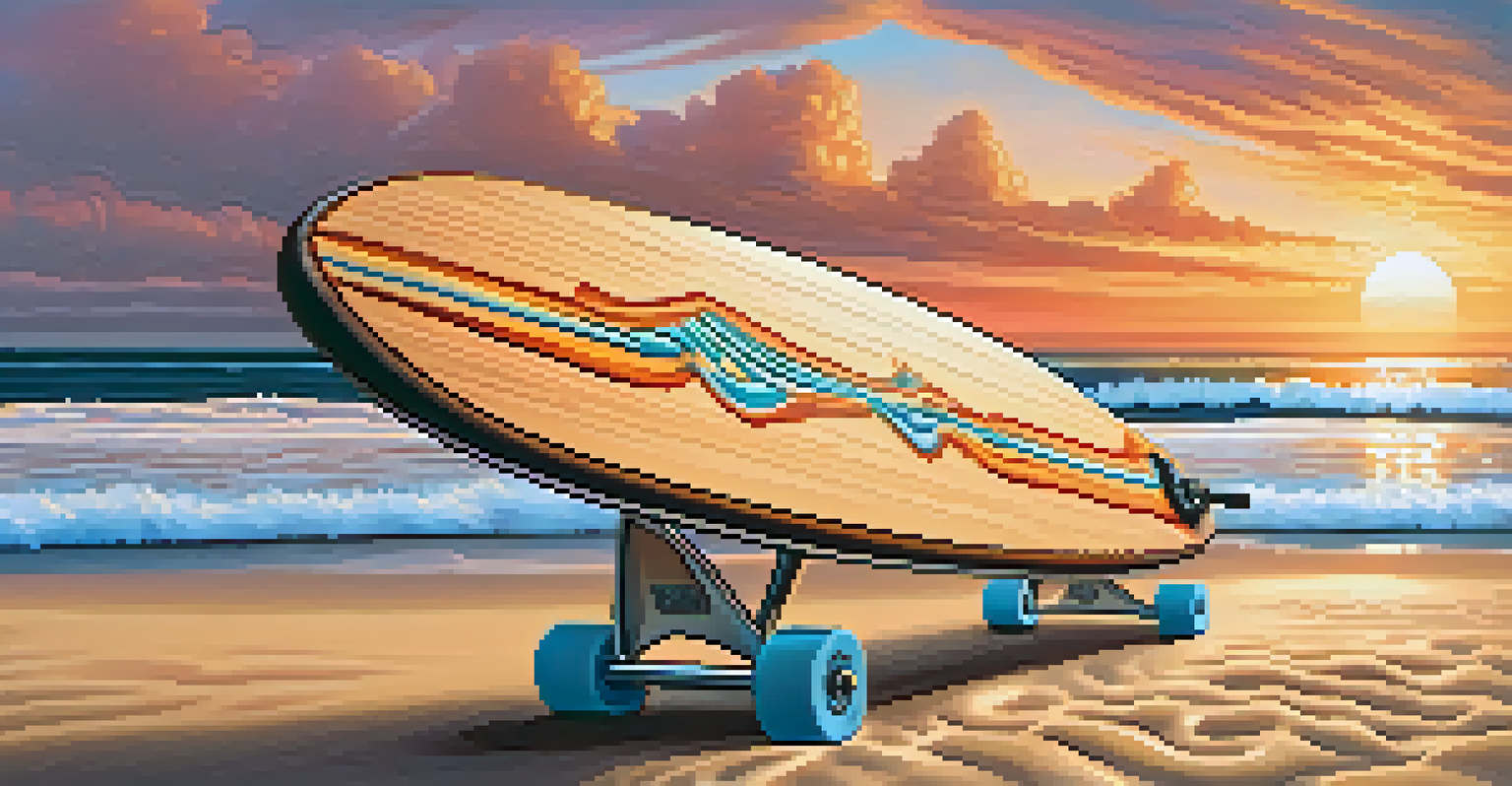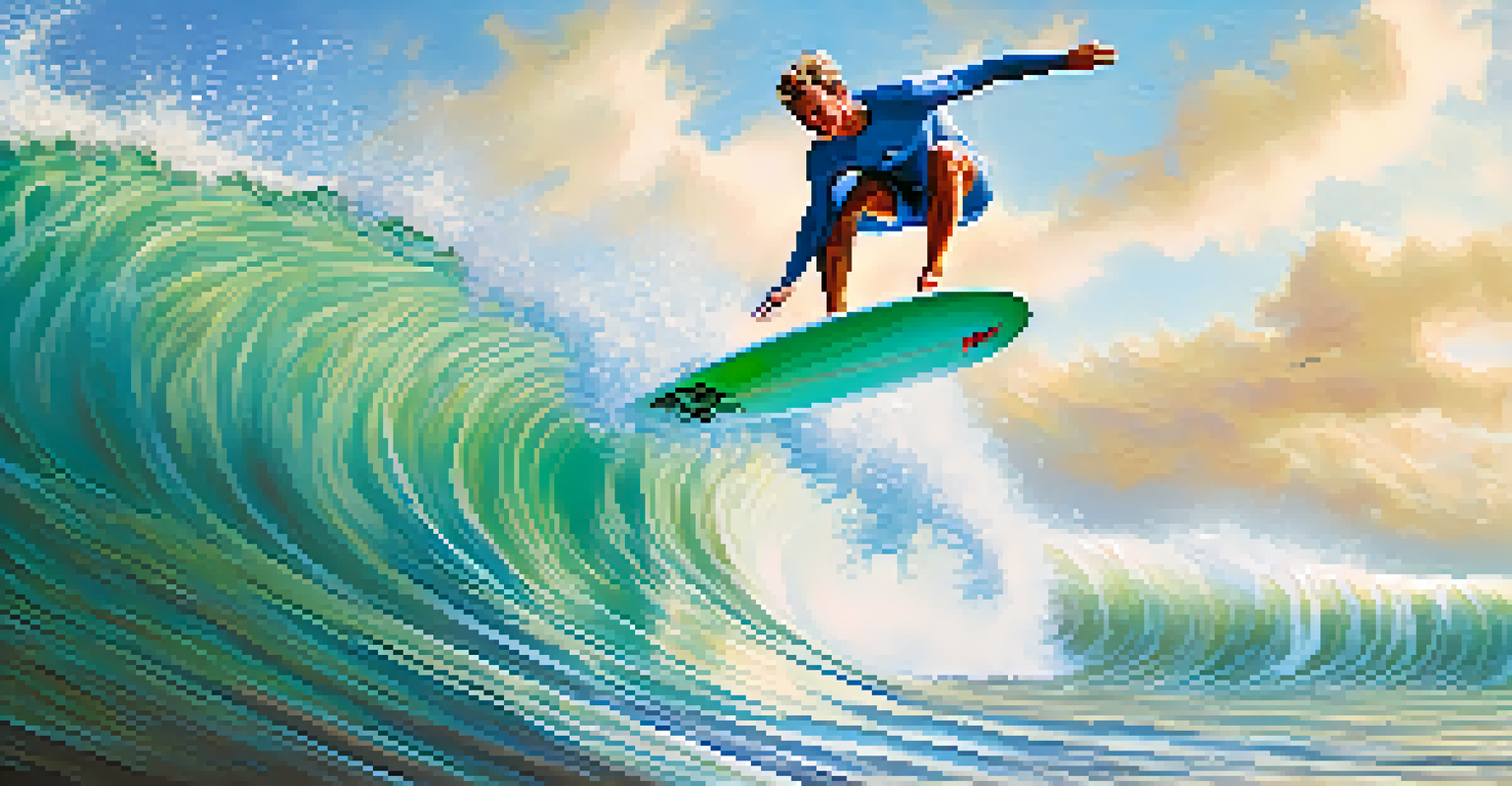Essential Surfboard Types: Choosing the Right One for You

Understanding the Basics of Surfboard Design
Surfboards come in various shapes and sizes, each designed for different surfing styles and conditions. At their core, surfboards are crafted to float and glide over water, but the specifics of their design can greatly affect performance. For example, a longer board typically provides more stability, making it ideal for beginners, while shorter boards allow for more maneuverability, perfect for advanced surfers.
Surfing is the most blissful experience you can have on this planet, a taste of heaven on earth.
The main components of a surfboard include the nose, tail, and rails, each contributing to how the board interacts with the waves. The materials used in construction, such as foam and fiberglass, also play a significant role in performance and durability. Understanding these basics will help you appreciate the nuances of various surfboard types.
Choosing the right surfboard starts with knowing your own skill level and the types of waves you plan to ride. This knowledge will guide you in selecting the perfect board that complements your surfing journey.
Longboards: The Classic Choice for Stability
Longboards, typically over 9 feet in length, are beloved for their stability and ease of paddling. They are perfect for beginners who are just getting a feel for riding the waves, thanks to their forgiving nature. The extra length helps surfers catch small waves more easily, making for a more enjoyable learning experience.

The design of longboards often features a rounded nose and a wider outline, which enhances their buoyancy and balance. Riders can enjoy a relaxed, laid-back style, often incorporating classic maneuvers like noseriding. This makes longboards a favorite not only for beginners but also for seasoned surfers looking to enjoy a leisurely day on the water.
Choose Boards for Your Skill Level
Selecting the right surfboard depends on your skill level and the types of waves you plan to ride.
If you're drawn to the idea of cruising along the waves and taking your time, a longboard might just be the perfect fit for you. Their timeless appeal and versatility make them a staple in the surfing community.
Shortboards: For the Thrill-Seeker and Advanced Surfer
Shortboards, usually ranging from 5 to 7 feet, are designed for high-performance surfing and are ideal for more experienced surfers. Their shorter length allows for quick turns and sharp maneuvers, making them perfect for riding bigger, more powerful waves. If you're looking to challenge yourself and push your limits, a shortboard could be your best option.
The best surfer out there is the one having the most fun.
These boards often feature a pointed nose and a narrower tail, which allows for greater control and responsiveness in the water. The design encourages aggressive surfing styles, including aerial tricks and rapid turns. However, the learning curve can be steep, so it's essential to have a solid foundation before transitioning to a shortboard.
If adrenaline and excitement are what you're after, investing in a shortboard could elevate your surfing experience. Just be prepared to put in some practice to master the techniques required for this dynamic style of riding.
Fish Surfboards: A Unique Blend of Fun and Versatility
Fish surfboards are characterized by their distinctive shape, featuring a wide tail and a shorter length, typically between 5’4” and 6’4”. This design allows them to excel in small to medium waves, making them a popular choice for surfers who enjoy a playful, agile ride. The wider tail provides extra lift and speed, helping surfers catch waves that might otherwise be tricky.
The fish shape also offers a unique surfing experience, allowing for smooth transitions and stylish turns. It's a fantastic option for those looking to experience a different style of riding while still maintaining a bit of stability. Plus, the fun factor of surfing on a fish board is hard to match, as they encourage creativity and experimentation on the waves.
Understand Surfboard Designs
Different surfboard shapes, such as longboards and shortboards, cater to various surfing styles and conditions.
If you love the idea of a versatile board that adapts well to varying conditions, a fish surfboard could be your ticket to a more enjoyable surfing adventure. They’re especially great for surfers who want to enhance their skills while having fun.
Hybrid Surfboards: The Best of Both Worlds
Hybrid surfboards combine elements from both longboards and shortboards, making them a versatile choice for a wide range of surfers. Typically featuring a wider nose and a shorter tail, hybrids aim to provide the stability of a longboard while maintaining the maneuverability of a shortboard. This design is excellent for surfers who enjoy a mix of styles and conditions.
These boards are perfect for those who want to ride everything from small beach breaks to bigger swells. With a hybrid, you can experiment with different techniques and find what works best for you without feeling locked into one specific style. This adaptability makes hybrids a popular choice for many surfers, regardless of their skill level.
If you're looking for a board that can grow with you as your skills develop, a hybrid surfboard could be the perfect solution. They offer a fantastic way to explore various aspects of surfing without the need for multiple boards.
Paddle Boards: For the Calm Waters and Fitness Enthusiasts
While not traditional surfboards, paddle boards have gained popularity for their versatility and fitness benefits. Stand-Up Paddleboarding (SUP) allows you to glide across calm waters, making it ideal for leisurely days on the lake or ocean. This activity combines balance, strength, and endurance, appealing to a broad audience, including those new to water sports.
Paddle boards are larger and wider than traditional surfboards, providing greater stability, which is great for beginners. They can also be used for various activities, including yoga, fishing, and even racing. This multi-functionality makes them an attractive option for anyone looking to get fit while enjoying the water.
Consider Materials and Durability
The materials used in surfboard construction can significantly affect performance, durability, and cost.
If you're seeking a low-impact workout or simply want to explore different water environments, paddle boards are an excellent choice. They offer a unique way to connect with nature while engaging in a fun, active lifestyle.
Surfboard Materials: Choosing What’s Right for You
The materials used in surfboard construction can significantly influence performance, durability, and cost. Common materials include polyurethane foam, epoxy, and polystyrene, each offering different benefits. For instance, epoxy boards are generally lighter and more durable, making them a great choice for surfers looking for longevity in their equipment.
In addition to the core material, the outer layer of fiberglass adds strength and protection, which can be crucial for maintaining your board over time. As you explore your options, consider how often you plan to use your board and the conditions you'll be surfing in, as this will inform your choice of materials.

Ultimately, understanding surfboard materials helps you make an informed decision that aligns with your surfing goals. Don't hesitate to ask your local surf shop for recommendations based on your specific needs and preferences.
Finding Your Perfect Surfboard: Tips and Considerations
When it comes to selecting the right surfboard, it’s essential to keep your personal style and experience level in mind. Take the time to reflect on your surfing goals, whether it’s to ride small waves, perform tricks, or simply enjoy the ocean. This self-awareness will guide you in choosing a board that complements your approach to surfing.
Don't be afraid to seek advice from experienced surfers or instructors, as they can provide invaluable insights based on their own experiences. Visiting local surf shops can also give you a chance to physically test different boards and find the one that feels right for you. Remember, the best surfboard is the one that not only meets your needs but also inspires confidence and joy every time you hit the waves.
Ultimately, finding your perfect surfboard is about balancing your preferences with practical considerations. With a little research and exploration, you’ll be well on your way to picking a board that enhances your surfing experience and keeps you stoked on the water.